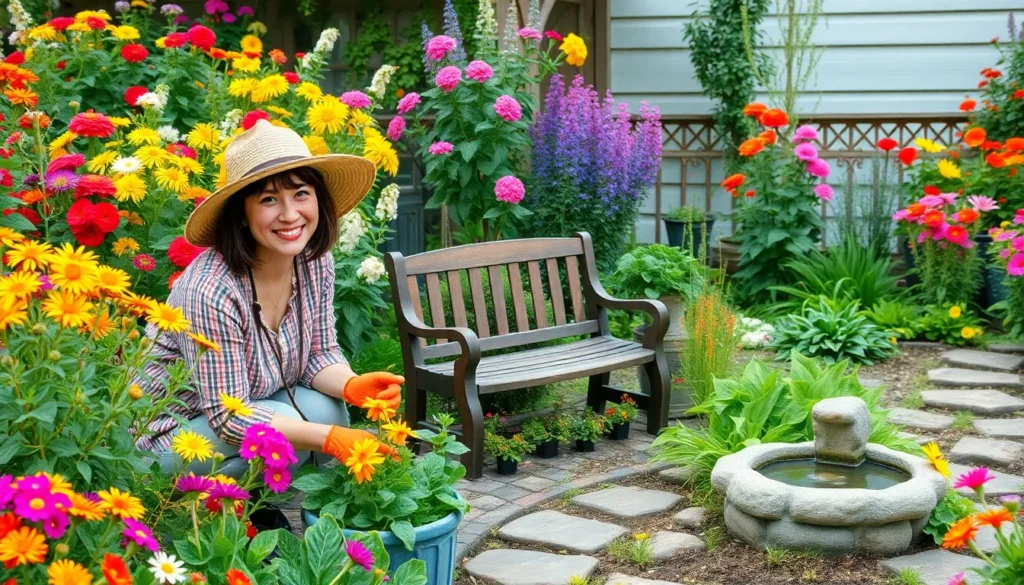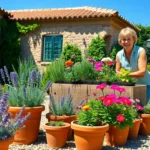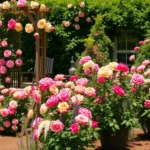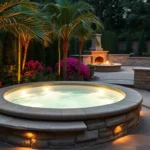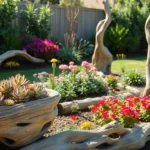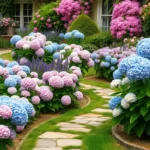We’ve all dreamed of transforming our outdoor spaces into stunning garden retreats that make neighbors stop and stare. Whether you’re working with a sprawling backyard or a cozy corner plot, designing a garden that reflects your personality while creating functional beauty doesn’t have to be overwhelming.
From selecting the perfect color palette with seasonal blooms to incorporating hardscape elements that add structure and interest, countless design possibilities await your creative vision. The key lies in understanding how to balance aesthetics with practicality – creating spaces that not only look magnificent but also thrive in your exact climate and soil conditions.
We’ll explore innovative design concepts that work for every budget and skill level, helping you create an outdoor sanctuary that becomes your favorite retreat. Get ready to discover how simple planning and strategic plant choices can transform any outdoor space into a garden masterpiece.
Start With Your Garden’s Purpose and Style
Before diving into plant selections and decorative elements, we need to establish the foundation that’ll guide every design decision throughout your garden transformation.
Define Your Garden’s Primary Function
Entertainment spaces require wide pathways, level surfaces, and designated areas for seating or dining. We recommend allocating at least 200 square feet for comfortable outdoor gatherings, with durable materials like flagstone or composite decking for high-traffic zones.
Food production gardens prioritize functionality over ornamental features, focusing on raised beds, irrigation systems, and tool storage. Vegetable gardens typically need 6-8 hours of direct sunlight daily and benefit from grid-like layouts that maximize growing space while allowing easy access for maintenance.
Relaxation retreats emphasize privacy, comfort, and sensory elements like fragrant plants or water features. These spaces work best in quieter corners of your property, incorporating screening elements like tall grasses, bamboo, or pergolas to create intimate enclosures.
Children’s play areas demand safety considerations, open sight lines for supervision, and resilient plants that can withstand foot traffic. We suggest avoiding thorny plants, toxic species, and delicate flowers in these zones while incorporating sturdy ground covers and sandbox areas.
Choose a Design Style That Reflects Your Personality
Modern minimalist gardens feature clean lines, geometric shapes, and limited plant palettes focusing on architectural plants like ornamental grasses and succulents. These designs typically use three or fewer plant varieties per area, creating bold statements through repetition and contrast.
Cottage garden styles embrace abundance and informal arrangements, mixing perennials, annuals, and herbs in seemingly random patterns. Traditional cottage gardens include climbing roses, lavender, delphiniums, and self-seeding flowers that create natural, lived-in appearances.
Mediterranean designs incorporate drought-tolerant plants, gravel pathways, and terra cotta elements that reflect warm-climate aesthetics. Key plants include olive trees, rosemary, sage, and ornamental grasses that thrive in well-drained soils and sunny exposures.
Japanese-inspired gardens emphasize balance, natural materials, and carefully curated plant selections including bamboo, Japanese maples, and moss. These spaces often feature stone elements, water features, and asymmetrical compositions that create peaceful, contemplative environments.
Consider Your Local Climate and Growing Conditions
Soil testing reveals pH levels, nutrient content, and drainage characteristics that determine which plants will thrive in your exact location. We recommend professional soil analysis every 3-5 years, as soil conditions can change due to weather patterns, nearby construction, or previous gardening practices.
Hardiness zones indicate average minimum winter temperatures in your area, helping you select plants that’ll survive seasonal temperature fluctuations. USDA zones range from 1 (coldest) to 11 (warmest), with each zone representing a 10-degree temperature range that affects plant survival rates.
Microclimates within your property create varying growing conditions based on sun exposure, wind patterns, and proximity to structures. South-facing slopes receive more intense sunlight and heat, while north-facing areas remain cooler and may retain moisture longer throughout growing seasons.
Seasonal rainfall patterns influence irrigation needs, plant selection, and garden maintenance schedules throughout the year. Areas receiving less than 30 inches of annual rainfall typically require drought-tolerant plants and efficient watering systems, while regions with abundant precipitation need plants that can handle moisture and potential flooding conditions.
Plan Your Garden Layout and Structure
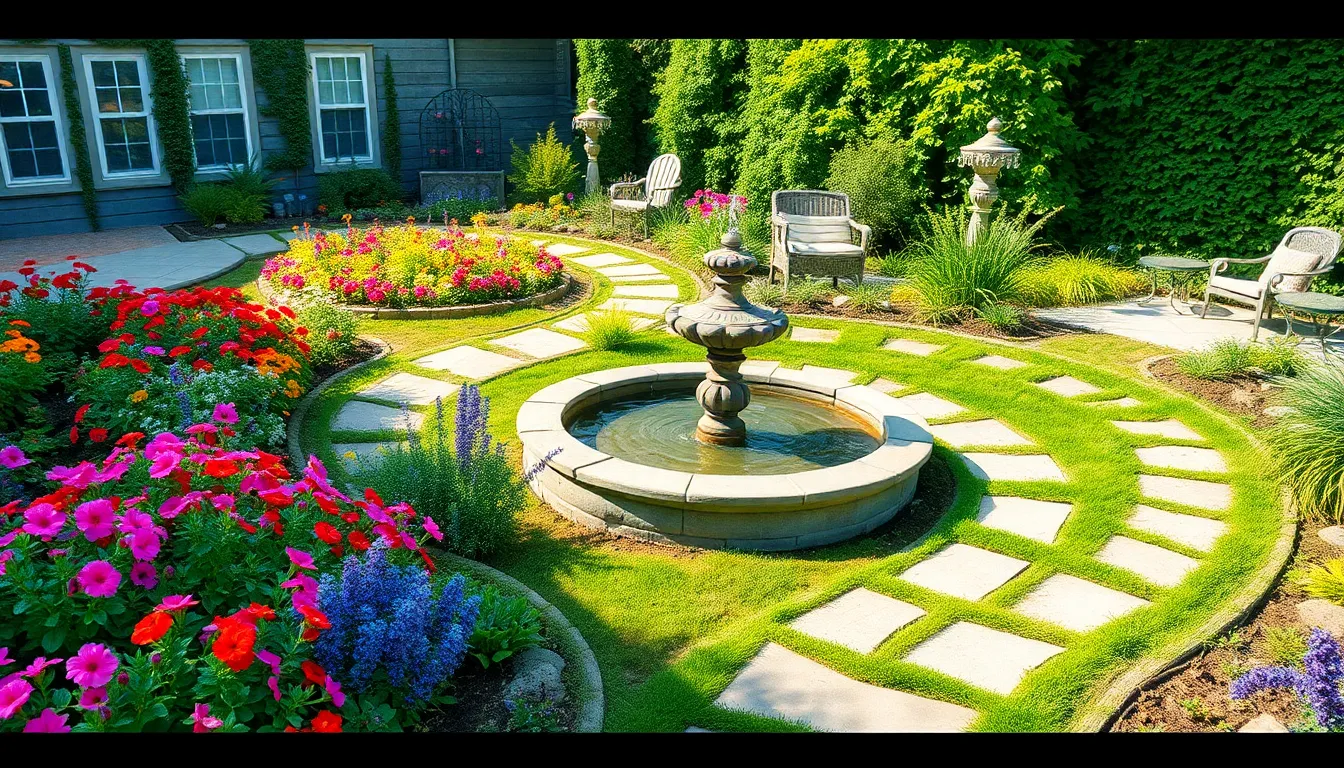
Once you’ve defined your garden’s purpose and style, it’s time to translate your vision into a well-organized physical space. Strategic layout planning transforms scattered ideas into a cohesive design that maximizes both beauty and functionality.
Create Zones for Different Activities
Vegetable or herb gardens work best when positioned in the sunniest areas of your yard, receiving at least six to eight hours of direct sunlight daily. We recommend grouping edible plants together for easier maintenance and harvesting access.
Flower gardens serve as decorative anchors throughout your industry design. Position these colorful displays near entrances, along property lines, or as transitional elements between different garden areas to create visual continuity.
Relaxation areas require careful consideration of privacy and comfort factors. Locate seating zones away from high traffic areas while ensuring easy access to your home for convenience during entertaining or quiet moments.
Children’s play spaces need open, level ground with good visibility from indoor living areas. Safety becomes paramount when designing these zones, so avoid placing them near water features or thorny plants.
Design Pathways and Traffic Flow
Material selection impacts both aesthetics and maintenance requirements for your garden walkways. Stone offers durability and natural beauty, while gravel provides excellent drainage and easy installation for DIY projects.
Width and accessibility determine how comfortably people can navigate your garden spaces. Primary walkways should measure at least three to four feet wide to accommodate two people walking side by side comfortably.
Curved pathways create more interesting visual journeys through your garden compared to straight lines. Gentle curves naturally guide visitors’ eyes and encourage exploration of different garden zones you’ve created.
Secondary paths connecting various garden areas can be narrower, typically 18 to 24 inches wide, while still maintaining safe passage for maintenance activities.
Establish Focal Points and Visual Interest
Water features serve as natural gathering spots and create soothing sounds that mask neighborhood noise. Ponds, fountains, or small waterfalls become conversation starters while attracting beneficial wildlife to your garden network.
Statues or sculptures add personality and artistic flair to outdoor spaces. Position these decorative elements at pathway intersections or garden corners where they’ll catch visitors’ attention without overwhelming plant displays.
Colorful plantings using varieties with different textures, heights, and bloom times create ever-changing visual appeal throughout growing seasons. Layer plants from tallest in back to shortest in front for optimal viewing and sun exposure.
Architectural elements like arbors, pergolas, or decorative screens provide vertical interest while serving practical purposes such as supporting climbing plants or creating privacy barriers.
Select Plants That Thrive in Your Space
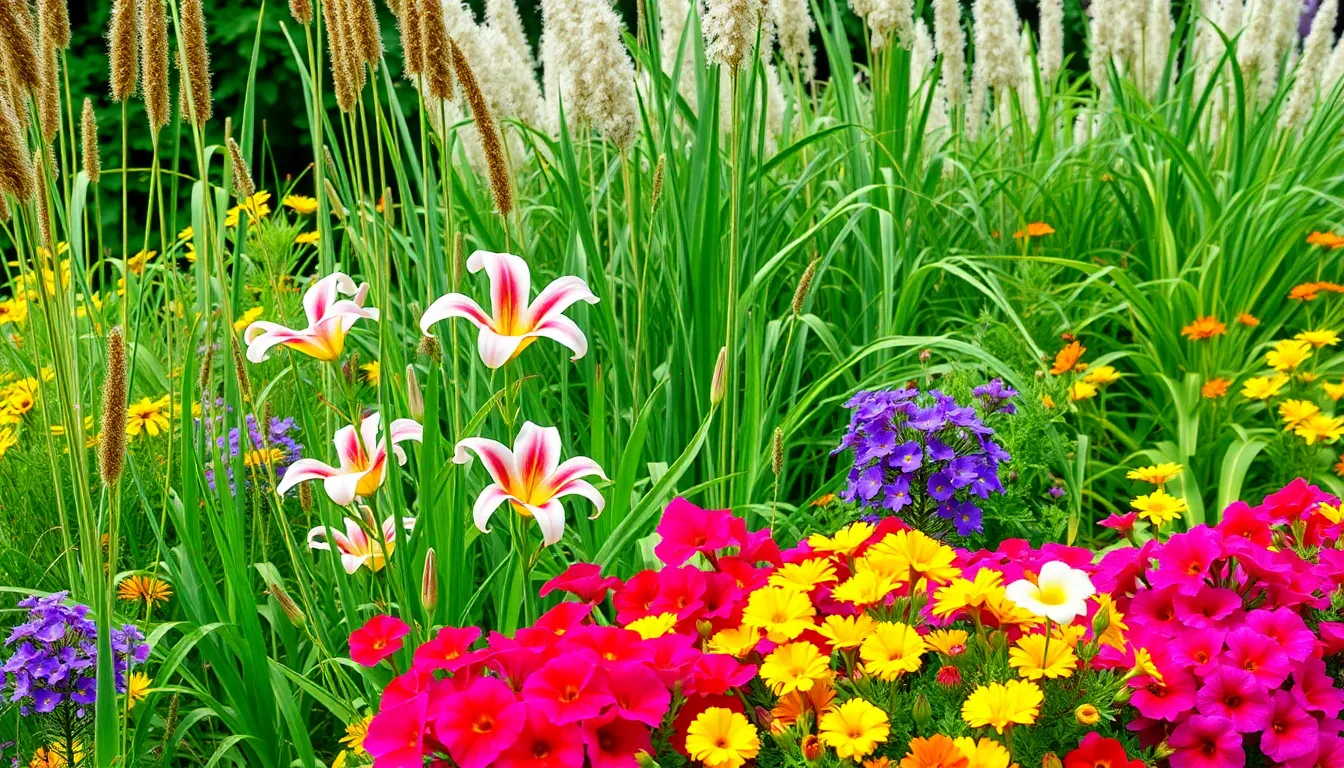
Smart plant selection forms the backbone of every successful garden design. We’ll focus on three key strategies that’ll help your garden flourish while minimizing maintenance headaches.
Choose Native Plants for Low Maintenance
Native plants offer the ultimate advantage for busy gardeners since they’re already adapted to local conditions. We recommend starting with these hardy performers because they require significantly less water, fertilizer, and pest control than exotic species. Local varieties like purple coneflower in prairie regions or manzanita in Mediterranean climates naturally resist common diseases and pests.
These indigenous species also support local wildlife ecosystems by providing food sources for native birds, butterflies, and beneficial insects. We’ve found that native plant gardens typically need 50% less irrigation once established compared to traditional landscaping. Many gardeners discover that their maintenance time drops dramatically after the second growing season.
Research your area’s native plant society or extension office for exact recommendations customized to your zip code’s growing conditions.
Mix Perennials and Annuals for Year-Round Color
Perennials provide the structural backbone of your garden since they return each season with reliable foliage and blooms. We suggest dedicating 70% of your planting space to these dependable performers like black-eyed Susan, daylilies, and ornamental grasses. These plants establish strong root systems that help prevent soil erosion while creating consistent visual anchors.
Annuals fill the gaps with vibrant seasonal color that you can change each year based on your mood or design preferences. Popular choices include marigolds, petunias, and impatiens that bloom continuously from spring until frost. We recommend using annuals as accent plants in containers, borders, or seasonal displays rather than as primary plantings.
This combination strategy ensures you’ll have blooms from early spring through late fall while maintaining a cohesive garden structure year after year.
Consider Plant Heights and Growth Patterns
Creating visual layers requires careful attention to mature plant sizes and spreading habits. We recommend placing tall specimens like ornamental grasses or flowering shrubs toward the back of beds, with medium height plants in the middle, and ground-hugging varieties in front. This arrangement prevents shorter plants from being overshadowed while creating natural depth.
Study each plant’s growth pattern before positioning it in your design since some species spread aggressively while others stay compact. Spacing guidelines on plant tags represent mature sizes, so we suggest following these measurements to prevent overcrowding issues down the road.
Plants with upright habits work well as vertical accents, while spreading varieties make excellent ground covers for slopes or large areas. We’ve learned that mixing different growth patterns creates more interesting textures and prevents monotonous garden beds that lack visual appeal.
Incorporate Hardscape Elements for Function and Beauty
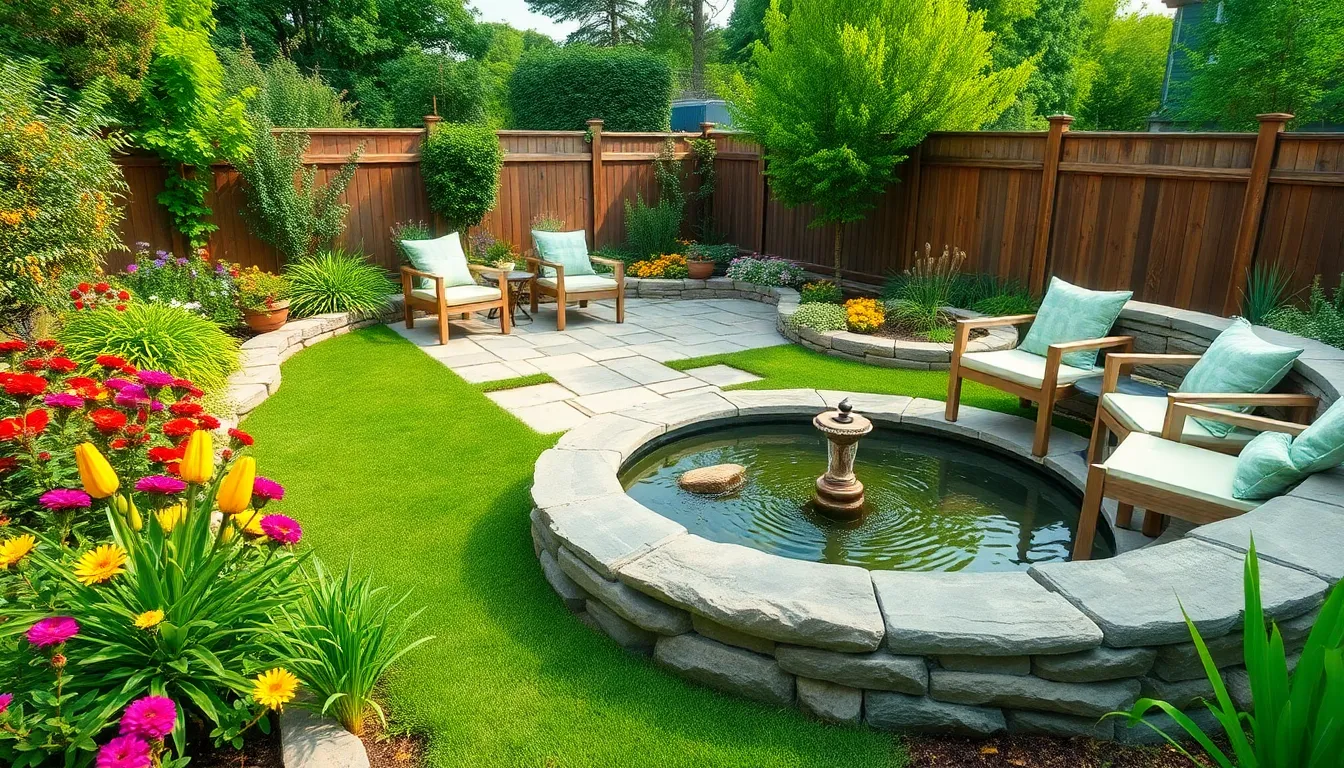
Hardscape elements form the structural backbone of any garden design, providing permanent features that enhance both functionality and visual appeal year-round. We recommend using materials like stone, pavers, concrete, gravel, wood, and metal to create a cohesive look that complements your home’s architectural style.
Add Patios and Seating Areas
Patios serve as central gathering spaces where families and friends can come together to enjoy outdoor living. We suggest choosing materials that harmonize with your surrounding industry while creating distinct zones for different activities. Stone patios offer timeless elegance, while concrete provides versatility and modern appeal.
Seating areas provide cozy spots for relaxation throughout your garden space. Built-in benches along retaining walls maximize space efficiency, while freestanding furniture allows for flexible arrangements. Consider incorporating outdoor fire pits to extend the usability of these spaces into cooler months.
Design these areas with comfort and functionality in mind. Weather-resistant materials ensure longevity, while strategic placement takes advantage of natural shade and privacy. Adding cushions and outdoor rugs creates inviting spaces that feel like outdoor rooms.
Install Water Features for Tranquility
Water features create soothing sounds that mask unwanted noise while adding visual focal points to garden designs. Fountains work well in formal settings, providing elegant vertical elements that draw the eye upward. Small waterfalls can transform sloped areas into stunning cascading displays.
Ponds offer opportunities to introduce aquatic plants and wildlife to your garden network. These features enhance biodiversity by attracting birds, butterflies, and beneficial insects. Even small container water gardens can provide similar benefits in limited spaces.
Maintenance considerations vary by feature type, with fountains requiring regular cleaning and ponds needing seasonal care. Solar-powered options reduce installation costs and environmental impact while providing gentle water movement throughout daylight hours.
Use Walls and Fences for Privacy and Structure
Walls and fences provide privacy while defining boundaries and creating intimate garden rooms. Retaining walls solve slope challenges while offering opportunities for terraced planting areas. These structures also support climbing plants like vines and flowering species that add vertical growing space.
Material selection impacts both aesthetics and longevity. Stone walls offer permanent answers with natural beauty, while wood fences provide warmth and can be customized to match your home’s style. Metal options like wrought iron combine durability with decorative appeal.
Strategic placement maximizes functionality without overwhelming garden spaces. Low walls can define planting beds while preserving sight lines, and taller structures create private retreats for relaxation areas. Incorporating gates and openings maintains accessibility while adding architectural interest to your overall design.
Design Seasonal Interest Throughout the Year
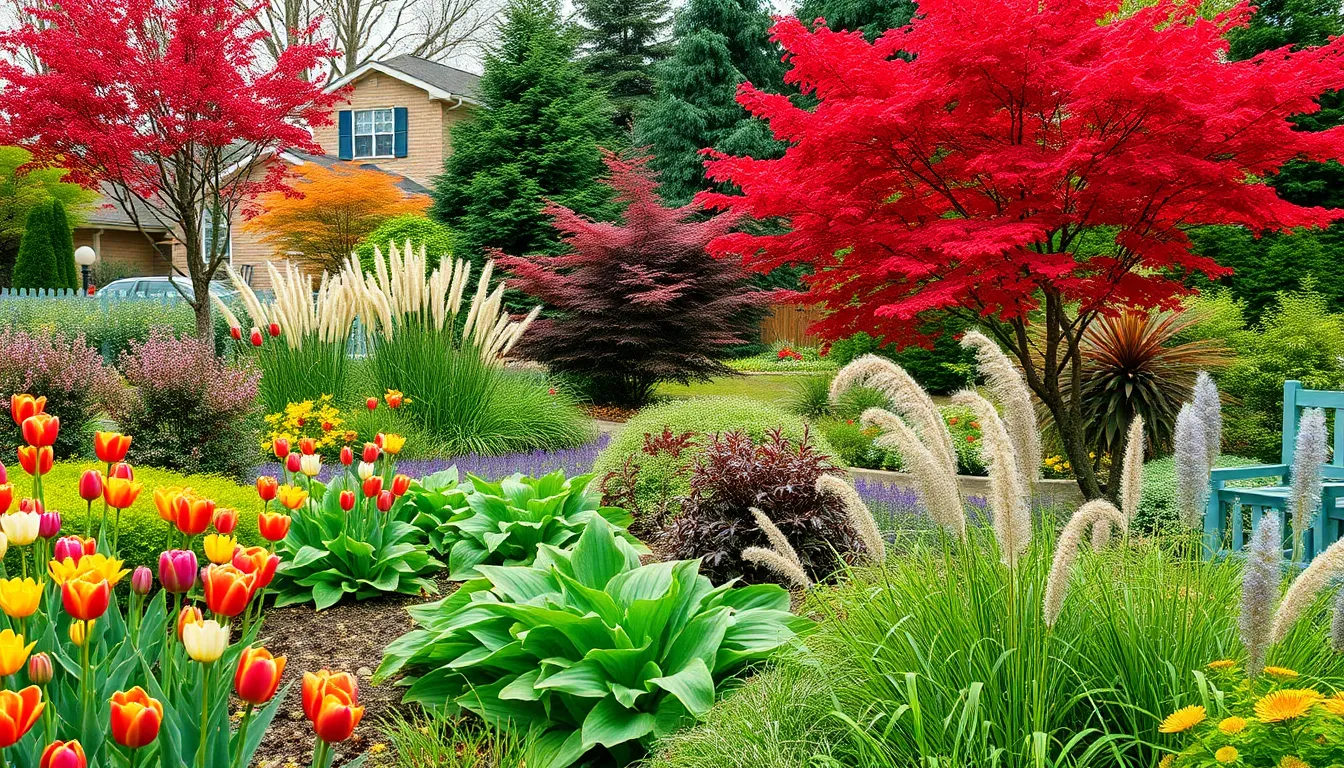
Creating a garden that captivates us every month requires strategic planning with plants that offer year-round beauty. We’ll achieve continuous visual appeal by selecting plants with different bloom times and incorporating structural elements that shine in each season.
Plan for Spring Blooms and Fresh Growth
Spring awakens our gardens with vibrant early bloomers that signal winter’s end. Crocuses and tulips provide the first splashes of color as temperatures warm, creating an immediate impact after months of dormancy. We recommend planting these bulbs in fall to ensure spectacular spring displays.
Fresh foliage emerges to complement early flowers and adds textural interest throughout the growing season. Hostas unfurl their broad leaves in shaded areas while ferns create delicate patterns in woodland settings. These plants establish the foundation for our garden’s green structure as other perennials begin their growth cycles.
Timing becomes crucial when we layer spring bloomers with emerging foliage plants. Early bulbs finish flowering just as hostas and ferns reach their full size, creating seamless transitions that maintain visual interest. We can extend spring color by selecting varieties with staggered bloom times from March through May.
Create Summer Color and Texture Combinations
Summer gardens demand plants that withstand heat while delivering consistent color throughout the longest season. Long-blooming flowers like iris provide reliable performance from early summer into fall, while Joe Pye weed creates dramatic late-season displays that attract beneficial pollinators. We choose these varieties for their extended flowering periods that reduce maintenance needs.
Texture combinations become essential for creating visual depth during peak growing season. Grasses add movement and softness when paired with the architectural forms of succulents and bold-leaved perennials. We can achieve striking contrasts by combining fine-textured ornamental grasses with broad hostas or spiky agaves.
Color coordination helps us create cohesive summer displays that avoid visual chaos. We group plants with complementary bloom times and colors, ensuring that intense summer heat doesn’t leave gaps in our design. Strategic placement of shade-providing trees allows us to grow a wider variety of plants in challenging summer conditions.
Include Fall Foliage and Winter Structure
Fall transforms our gardens with spectacular foliage displays that rival spring flowers in their impact. Japanese maples provide brilliant red and orange colors while offering year-round structural interest with their graceful branching patterns. We select varieties based on mature size and fall color intensity to maximize seasonal drama.
Berry-producing shrubs like hawthorn extend autumn interest while providing food sources for wildlife. These plants offer multiple seasons of beauty through spring flowers, summer foliage, and colorful fall berries that persist into winter. We position these shrubs where their winter silhouettes will create attractive focal points against snow or bare ground.
Winter structure maintains our garden’s bones when herbaceous plants die back to ground level. Evergreen trees provide consistent green color while winter-blooming plants like hellebores and witch hazels offer unexpected seasonal surprises. We rely on the textural qualities of bark and persistent seed heads to create interest during the dormant season, ensuring our gardens remain captivating throughout the coldest months.
Add Lighting to Extend Garden Enjoyment
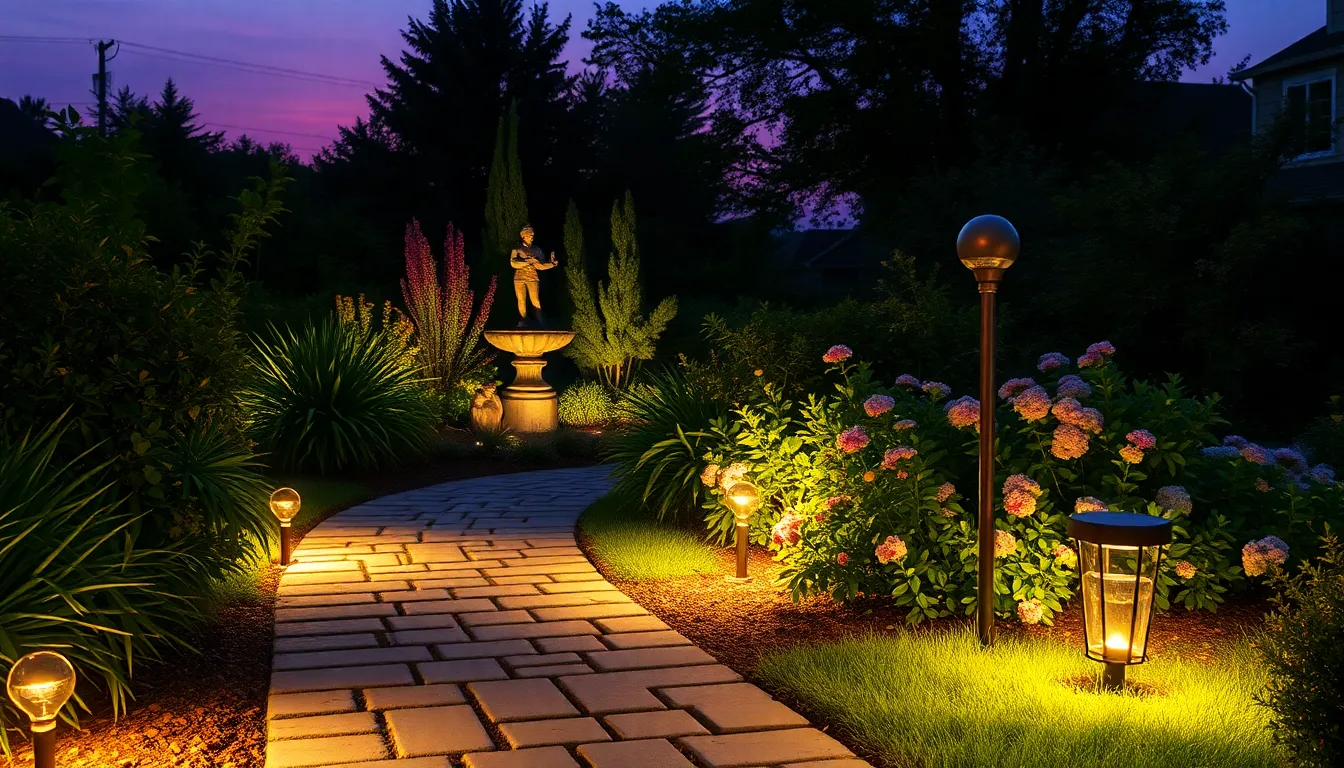
Strategic lighting transforms our garden spaces into enchanting evening retreats that we can enjoy long after sunset. Well-planned illumination enhances both safety and beauty while extending the usable hours of our outdoor sanctuary.
Install Path Lighting for Safety and Ambiance
Pathway lighting creates essential safety corridors while adding welcoming ambiance to our garden design. Low-voltage lights positioned along walkways ensure safe navigation during evening hours and establish an inviting atmosphere for guests. These fixtures prevent accidents on uneven surfaces and highlight the natural flow of our garden’s circulation patterns.
Step lighting enhances visibility on stairs and raised garden beds while contributing visual appeal. Installing these specialized fixtures on each step eliminates dangerous shadows and creates dramatic architectural interest. We can choose from recessed options that blend seamlessly or decorative fixtures that become design elements themselves.
Strategic placement maximizes both function and aesthetics in our lighting scheme. Spacing lights every 6 to 8 feet along pathways provides consistent illumination without creating harsh glare. This interval creates a gentle rhythm that guides movement while maintaining the garden’s natural ambiance.
Highlight Key Features With Accent Lighting
Accent lighting showcases our garden’s most beautiful elements as dramatic focal points. Spotlights directed at statues, fountains, or specimen trees create stunning visual anchors that draw attention after dark. These features become even more captivating when illuminated against the darkness of night.
Backlighting techniques on potted trees generate soft, ethereal glows that highlight foliage textures. This approach creates depth and dimension while casting intricate shadow patterns on nearby surfaces. The gentle illumination transforms ordinary container plants into extraordinary design statements.
Water feature lighting with adjustable spotlights emphasizes these elements as plants mature around them. Fountains and waterfalls become mesmerizing centerpieces when properly lit, with the interplay of light and moving water creating ever-changing visual interest. Adjustable fixtures allow us to modify the lighting as surrounding vegetation grows and changes.
Gazebo lighting creates balanced ambiance by highlighting our favorite surrounding plants and trees. This technique establishes intimate gathering spaces while showcasing the natural beauty that frames these structures. The combination creates a harmonious blend of architecture and industry.
Consider Solar Options for Eco-Friendly Illumination
Solar-powered lights offer energy-efficient illumination without requiring additional electrical wiring. These eco-friendly fixtures harness sunlight during the day to provide gentle lighting throughout the evening hours. Installation becomes remarkably simple since we don’t need to run electrical lines or hire professionals for complex wiring projects.
Solar stake lights distributed throughout the garden provide ambient illumination without electricity costs. These versatile fixtures can be repositioned easily as our garden evolves and plant arrangements change. Many models offer automatic sensors that turn on at dusk and off at dawn, requiring minimal maintenance once installed.
Modern solar technology delivers reliable performance with improved battery life and LED efficiency. Today’s solar garden lights can provide 8 to 12 hours of continuous illumination after a full day of charging. Weather-resistant designs ensure consistent operation through various seasonal conditions while maintaining their attractive appearance year-round.
Create Functional Spaces for Daily Living
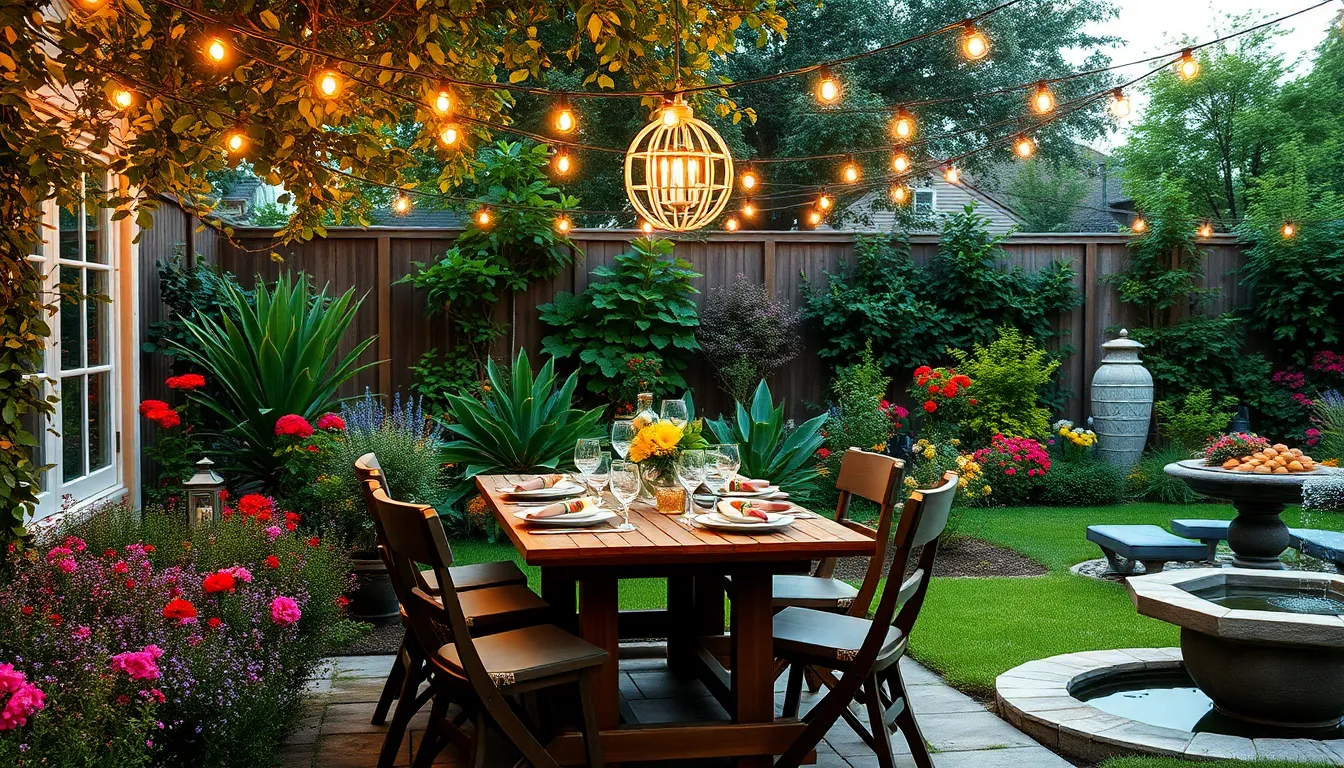
Functional garden spaces transform our outdoor environments into extensions of our homes where daily activities flow seamlessly between indoor and outdoor living. We’ll explore three essential approaches to maximize garden utility while maintaining beautiful aesthetics.
Design Outdoor Dining and Entertainment Areas
Outdoor lighting transforms dining spaces into enchanting evening retreats where families and friends can gather long after sunset. Strategic placement of lighting elements highlights key architectural features while creating warm ambiance that makes every meal feel special. We recommend installing pathway lights along walkways leading to dining areas and adding accent lighting to showcase garden focal points nearby.
Garden water features elevate entertainment spaces by providing soothing background sounds that mask neighborhood noise. Small ponds or fountains near seating areas create natural conversation starters while adding visual interest to the space. These features work particularly well when positioned within view of dining tables where guests can enjoy the movement and sound of water.
Seating areas become the heart of outdoor entertainment when designed with comfort and functionality in mind. Foldable chairs and small tables offer flexibility for different group sizes while maintaining clean lines when not in use. We suggest creating multiple intimate seating clusters rather than one large area to encourage natural conversation flow and accommodate various activities simultaneously.
Include Storage Answers for Garden Tools
Garden sheds provide comprehensive storage answers that keep tools organized and readily accessible while maintaining a clutter free outdoor environment. Purpose built sheds can house everything from lawn mowers to small hand tools while protecting equipment from weather elements. We recommend positioning sheds in convenient locations that don’t obstruct main garden views but remain easily accessible from work areas.
Hidden compartments offer discrete storage options for frequently used tools and gardening accessories without disrupting the garden’s aesthetic appeal. Large decorative planters with built in storage compartments can hold hand tools, gloves, and small watering equipment. These dual purpose answers maintain garden beauty while providing practical access to essential items during regular maintenance tasks.
Plan Maintenance Access and Work Areas
Pathways help easy movement throughout the garden while reducing soil compaction and erosion in high traffic areas. Well designed walkways connect different garden zones efficiently and provide stable surfaces for moving equipment and materials. We suggest using materials that complement the overall garden design while offering durability for regular use.
Work stations create dedicated spaces for potting and gardening tasks that keep messy activities contained and organized. A designated area with a small bench and nearby storage eliminates the need to carry tools and supplies back and forth from distant locations. These stations work best when positioned near water sources and main garden areas for maximum efficiency during planting and maintenance activities.
Conclusion
We believe that every outdoor space holds incredible potential waiting to be unlocked through thoughtful garden design. By combining practical planning with creative vision you can transform any area into a stunning retreat that reflects your personal style.
Remember that successful garden design isn’t about perfection—it’s about creating spaces that bring you joy throughout the seasons. Whether you’re working with native plants or adding dramatic lighting effects each element should serve both form and function.
Your garden journey starts with a single step. Take time to assess your space define your goals and begin implementing these design strategies at your own pace. With patience and creativity you’ll soon have the outdoor sanctuary you’ve always dreamed of.
Frequently Asked Questions
What’s the first step in designing a garden?
Define your garden’s primary function before planning anything else. Decide whether you want space for entertainment, food production, relaxation, or children’s play. Each purpose requires different considerations for space allocation, materials, and safety features. This foundational decision will guide all your subsequent design choices and ensure your garden meets your specific needs.
How do I choose the right garden design style?
Select a style that reflects your personal taste and complements your home’s architecture. Popular options include modern minimalist for clean lines, cottage style for informal charm, Mediterranean for drought-resistant elegance, or Japanese-inspired for zen tranquility. Each style has unique plant selections and layout requirements that create distinct atmospheres.
What factors should I consider for plant selection?
Focus on your local climate, soil conditions, and hardiness zone first. Test your soil and understand seasonal rainfall patterns. Choose native plants for 70% of your garden as they require less maintenance and support local wildlife. Use perennials for structure and annuals for seasonal color to ensure year-round interest.
How important are hardscape elements in garden design?
Hardscape elements like patios, pathways, and water features are essential for both functionality and visual appeal. They create structure, define spaces, and provide year-round interest. Choose materials that complement your home’s architecture and consider maintenance requirements. Well-designed hardscaping can transform your garden into a cohesive outdoor living space.
How can I ensure my garden looks good throughout all seasons?
Plan for seasonal interest by selecting plants with staggered bloom times from spring through fall. Include evergreens for winter structure and plants with interesting bark or seed heads. Incorporate textures and colors that provide visual depth. Consider winter-blooming plants and decorative elements to maintain appeal during dormant seasons.
What role does lighting play in garden design?
Strategic lighting extends garden enjoyment into evening hours while enhancing safety and beauty. Use pathway lighting for navigation, step lighting for visibility, and accent lighting to highlight key features. Solar lighting options provide eco-friendly illumination without complex wiring, making your garden an enchanting retreat after dark.
How do I create functional outdoor living spaces?
Design spaces that flow seamlessly between indoor and outdoor activities. Create dedicated areas for dining, entertainment, and relaxation with comfortable seating and appropriate lighting. Include practical storage solutions like garden sheds or hidden compartments to maintain a clutter-free environment while keeping tools and supplies accessible.
What’s the best approach for garden layout and pathways?
Create distinct zones for different activities, positioning sun-loving plants like vegetables in bright areas and relaxation spaces with privacy considerations. Design pathways that facilitate smooth traffic flow using materials that balance aesthetics with maintenance needs. Establish focal points like water features or sculptures to add visual interest and guide movement through the space.

